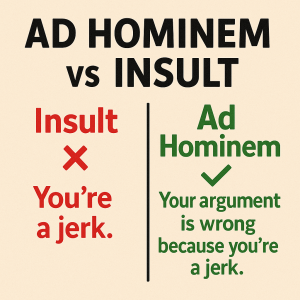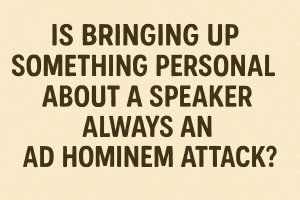Ad Hominem Attacks
Kainan Jarrette and Diana Daly
What is an ad hominem attack?

An ad hominem attack is when someone attacks the speaker rather than the argument, as a means of invalidating the argument.
The term comes from Latin (yes, it’s that old), meaning “to the person.” It was popularized to a new level by philosopher John Locke in the 17th century.
Examples


How to Spot an Ad Hominem attack
Ad hominem attacks are usually very easy to spot because they target the speaker. However, we can often excuse or ignore them when they’re attacking a speaker we already don’t like.
As discussed below, though, ad hominem attacks are always counter-productive to true argumentation and logic — don’t let them slide, no matter who is making them!
Ad Hominem Attacks vs Insults
There’s an important distinction to make between ad hominem attacks and insults: an ad hominem attack is an insult used to invalidate an argument.

Exceptions
At this point, you may be asking yourself:

No, not necessarily! If the personal information about the speaker is truly relevant to what’s being debated, then bringing it up may be appropriate.
However, there are generally only two areas it would be (potentially) relevant:
01. The speaker is part of the topic at hand.

02. The speaker is claiming expertise or authority on the topic at hand.

What’s important to keep in mind is that the personal information that’s brought up shouldn’t feel like an insult. If, in the above cartoon, the response had been “You lost your medical license for malpractice because you’re a monster!” the bulk of the response may be appropriate, but the insult undermines your credibility.
Remember: just stick to the facts.
Why ad hominem attacks Matter
Ad hominem attacks pull double duty, acting as both a personal insult and a distraction. They also have a particular allure because they directly tap into our emotions. But ultimately all an ad hominem attack does is help turn a civilized argument into a fight, increasing polarization.
Look Who’s Talking!

All of us have emotions, and so we can all occasionally make the mistake of resorting to an ad hominem attack. But if you see a speaker who frequently insults opposing speakers, they’re likely doing so as an intentional rhetorical strategy, meant to manipulate the audience. This should raise serious red flags, as it undermines their credibility as an accurate source of information.
Knowledge Check: Ad Hominem Attacks
Vocabulary
ad hominem attack
when someone attacks the speaker rather than the argument, as a means of invalidating the argument
rhetorical strategy
any deliberate technique a speaker or writer uses to persuade, influence, or shape how an audience thinks or feels about an issue.
Media Attributions
- Ad Hominem Title © ChatGPT is licensed under a CC0 (Creative Commons Zero) license
- Ad Hominem Comic 01 © ChatGPT is licensed under a CC0 (Creative Commons Zero) license
- Ad Hominem Comic 02 © ChatGPT is licensed under a CC0 (Creative Commons Zero) license
- Ad Hominem Vs Insult © ChatGPT is licensed under a CC0 (Creative Commons Zero) license
- Ad Hominem Text 01 © ChatGPT is licensed under a CC0 (Creative Commons Zero) license
- People Person © ChatGPT is licensed under a CC0 (Creative Commons Zero) license
- Malpractice © ChatGPT is licensed under a CC0 (Creative Commons Zero) license
- Verbal Anger © ChatGPT is licensed under a CC0 (Creative Commons Zero) license
a logical fallacy where someone attacks the speaker rather than the argument, as a means of invalidating the argument
any deliberate technique a speaker or writer uses to persuade, influence, or shape how an audience thinks or feels about an issue

